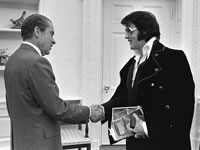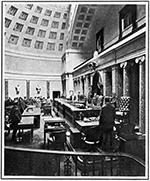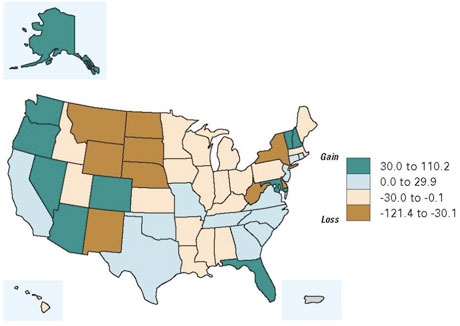1. Runyon v. McCrary, 1976: Private schools may not discriminate on the basis of race.
The Court decided that the 1871 Civil Rights Act gave the federal government power to override private as well as state-supported racial discrimination.
2. Epperson v. Arkansas, 1968: Prohibiting the teaching of evolution in public schools is unconstitutional.
The Court took on the case despite the fact that the state of Arkansas had never attempted to enforce its statute against teaching evolution.
3. Brown v. Board of Education of Topeka, 1954: Racial segregation in public schools is unconstitutional.
State laws that had set up "separate but equal" schools for black students and white students were overturned, because such schools were "inherently unequal," and so violated the Equal Protection Clause of the 14th Amendment.
4. Meyer v. Nebraska, 1923: Prohibiting the teaching of foreign languages in grade schools is unconstitutional.
A Nebraska law had prohibited the teaching (before high school) of any subject to any child in any language other than English. The plaintiff was a parochial school teacher who had taught German to one of his students.
5. Abington School District v. Schempp, 1963: Requiring the reading of Bible verses in public school classrooms is unconstitutional.
A Pennsylvania State law had required public schools to open each day with a reading, without comment, of 10 Bible verses.
6. Pierce v. Society of Sisters of the Holy Names of Jesus and Mary, 1925: Parents may send their children to private schools rather than public schools.
The State of Oregon had been on the verge of forcing all children to attend public schools in order to encourage immigrants' assimilation.
7. Engel v. Vitale, 1962: Requiring the recitation in public schools of an official school prayer is unconstitutional.
A Hyde Park, New York, school had opened each school day with a prayer addressed "Almighty God," which the Court held violated the Establishment Clause of the 1st Amendment (extended to the individual states by the 14th Amendment).
8. United States v. Virginia, 1996: Excluding either gender from any public school is unconstitutional.
The Court ruled that the Virginia Military Institute had not demonstrated a persuasive reason for excluding women, and so violated the Equal Protection Clause of the 14th Amendment.
9. Wisconsin v. Yoder, 1972: Parents may refuse to send their children to school after 8th grade if it violates their religious beliefs.
Amish parents had taken their children out of school after 8th grade, for religious reasons, and state authorities had attempted to force them to attend high school.
10. Tinker v. Des Moines Independent Community School District, 1969: Student protest is protected by 1st Amendment freedom of speech.
The protest in question was students' wearing of black armbands with peace symbols during the Vietnam War.
 John Adams, from Abigail Adams (pictured). Abigail Adams wrote this to her husband in a December 23, 1782 letter. The original letter can be read
John Adams, from Abigail Adams (pictured). Abigail Adams wrote this to her husband in a December 23, 1782 letter. The original letter can be read  Woodrow Wilson, to Edith Bolling Galt (pictured). This is from a letter that widower President Wilson wrote from the White House on September 19, 1915, to Edith Bolling Galt, whom he would marry. The full text of the letter is in volume 34 of The Papers of Woodrow Wilson, ed. Arthur Stanley Link (Princeton, NJ: Princeton University Press, 1994), page 491.
Woodrow Wilson, to Edith Bolling Galt (pictured). This is from a letter that widower President Wilson wrote from the White House on September 19, 1915, to Edith Bolling Galt, whom he would marry. The full text of the letter is in volume 34 of The Papers of Woodrow Wilson, ed. Arthur Stanley Link (Princeton, NJ: Princeton University Press, 1994), page 491. Ronald Reagan, to Nancy Reagan (pictured). This is from a letter written on White House stationery by Ronald Reagan, to his wife Nancy on March 4, 1981. From Nancy Reagan, I Love You, Ronnie: The Letters of Ronald Reagan to Nancy Reagan (New York: Random House, 2002).
Ronald Reagan, to Nancy Reagan (pictured). This is from a letter written on White House stationery by Ronald Reagan, to his wife Nancy on March 4, 1981. From Nancy Reagan, I Love You, Ronnie: The Letters of Ronald Reagan to Nancy Reagan (New York: Random House, 2002). Theodore Roosevelt, about Alice Lee (pictured). This is from Roosevelt's diary entry of February 13, 1880. On that evening, he became engaged to Alice Lee, whom he married. On Valentine's Day, 1884, she died while giving birth to their daughter Alice. Roosevelt's mother died the same day. His diary entry for that day is simply a large black X with the words, "The light has gone out of my life." The Library of Congress has made scans of the original diary pages, available online
Theodore Roosevelt, about Alice Lee (pictured). This is from Roosevelt's diary entry of February 13, 1880. On that evening, he became engaged to Alice Lee, whom he married. On Valentine's Day, 1884, she died while giving birth to their daughter Alice. Roosevelt's mother died the same day. His diary entry for that day is simply a large black X with the words, "The light has gone out of my life." The Library of Congress has made scans of the original diary pages, available online 

 False. Advertising executive Rosser Reeves had previously created the "melts in your mouth, not in your hands" campaign for M&Ms. The campaign he planned for Eisenhower—20-second spots designed to run before or after popular television shows like I Love Lucy—featured "normal Joe" citizens asking Eisenhower questions about taxes, foreign policy, and other issues. Eisenhower answered in a brief, blunt, homey fashion, with the format giving the campaign its name: "Eisenhower Answers America." Prior to this campaign, presidential candidates had brushed off the potential of television advertising; following it, ads became an accepted and increasingly central aspect of campaigning.
False. Advertising executive Rosser Reeves had previously created the "melts in your mouth, not in your hands" campaign for M&Ms. The campaign he planned for Eisenhower—20-second spots designed to run before or after popular television shows like I Love Lucy—featured "normal Joe" citizens asking Eisenhower questions about taxes, foreign policy, and other issues. Eisenhower answered in a brief, blunt, homey fashion, with the format giving the campaign its name: "Eisenhower Answers America." Prior to this campaign, presidential candidates had brushed off the potential of television advertising; following it, ads became an accepted and increasingly central aspect of campaigning. True. JFK's 1960 campaign for the presidency, run by two different advertising agencies, included a multitude of television advertisements and a dizzying array of techniques and appeals. Several of the ads spoke out to specific demographics—including a spot in which Jackie Kennedy, speaking in uneven Spanish, assured voters that, in the face of the danger of communism, "Mi esposo siempre vigilará los intereses de todos los sectores de nuestra sociedad que necesitan la protección de un gobierno humanitario" (or, "My husband will always watch over the interests of all sectors of our society who are in need of the protection of a humanitarian government"). Other ads spoke to the African American community, assuring the public that Kennedy's Catholicism would not compromise his presidential duties.
True. JFK's 1960 campaign for the presidency, run by two different advertising agencies, included a multitude of television advertisements and a dizzying array of techniques and appeals. Several of the ads spoke out to specific demographics—including a spot in which Jackie Kennedy, speaking in uneven Spanish, assured voters that, in the face of the danger of communism, "Mi esposo siempre vigilará los intereses de todos los sectores de nuestra sociedad que necesitan la protección de un gobierno humanitario" (or, "My husband will always watch over the interests of all sectors of our society who are in need of the protection of a humanitarian government"). Other ads spoke to the African American community, assuring the public that Kennedy's Catholicism would not compromise his presidential duties.  False. Nixon's 1972 campaign for reelection cast him as a man of "compassion, courage, and conscience," concerned about many issues, including environmentalism and international diplomacy, as well as withdrawing from Vietnam. President Nixon, one ad declared, was willing to press for change, because "without change there can be no progress." The ads crafted the argument that Nixon, far from being cold and unapproachable, was personable and personally interested in a global push for peace and wellbeing nationally and internationally. Nixon won the campaign against South Dakota Senator George McGovern by a landslide.
False. Nixon's 1972 campaign for reelection cast him as a man of "compassion, courage, and conscience," concerned about many issues, including environmentalism and international diplomacy, as well as withdrawing from Vietnam. President Nixon, one ad declared, was willing to press for change, because "without change there can be no progress." The ads crafted the argument that Nixon, far from being cold and unapproachable, was personable and personally interested in a global push for peace and wellbeing nationally and internationally. Nixon won the campaign against South Dakota Senator George McGovern by a landslide. False. Though most of Ronald Reagan's ads stressed the economic wellbeing of the U.S., using montages of small-town Americans engaged in rituals such as weddings and buying new homes, one stuck out. The unusual ad showed a bear lurking in the woods; the accompanying narration suggested that the bear might or might not exist and might or might not be dangerous, but "since no one can really be sure who's right, isn't it smart to be as strong as the bear? If there is a bear?" Though the ad never explicitly states what the bear stands for, the advertisement's creators intended it to symbolize the Soviet Union. The ad's watchers, however, took it as commenting on any number of issues, including gun control and the need for change in environmental laws. Despite its ambiguity, the ad gained attention and later served as inspiration for an ad in George W. Bush's 2004 reelection campaign.
False. Though most of Ronald Reagan's ads stressed the economic wellbeing of the U.S., using montages of small-town Americans engaged in rituals such as weddings and buying new homes, one stuck out. The unusual ad showed a bear lurking in the woods; the accompanying narration suggested that the bear might or might not exist and might or might not be dangerous, but "since no one can really be sure who's right, isn't it smart to be as strong as the bear? If there is a bear?" Though the ad never explicitly states what the bear stands for, the advertisement's creators intended it to symbolize the Soviet Union. The ad's watchers, however, took it as commenting on any number of issues, including gun control and the need for change in environmental laws. Despite its ambiguity, the ad gained attention and later served as inspiration for an ad in George W. Bush's 2004 reelection campaign. To watch all of the ads mentioned in this quiz, check out the Museum of the Moving Image's website
To watch all of the ads mentioned in this quiz, check out the Museum of the Moving Image's website 




 For more on major U.S. Supreme Court cases, try a search in our
For more on major U.S. Supreme Court cases, try a search in our 






